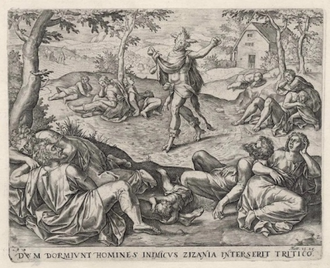Gospel in Art: Let them both grow till the harvest

The Parable of the Wheat and Tares, Engraved by Pieter Jalhea Furnius,1585, after Gerard van Groeningen. Publisher Gerard de Jose.
Source: Christian Art
Matthew 13:24-30
Jesus put another parable before the crowds: 'The kingdom of heaven may be compared to a man who sowed good seed in his field. While everybody was asleep his enemy came, sowed darnel all among the wheat, and made off. When the new wheat sprouted and ripened, the darnel appeared as well. The owner's servants went to him and said, "Sir, was it not good seed that you sowed in your field? If so, where does the darnel come from?" "Some enemy has done this" he answered. And the servants said, "Do you want us to go and weed it out?" But he said, "No, because when you weed out the darnel you might pull up the wheat with it. Let them both grow till the harvest; and at harvest time I shall say to the reapers: First collect the darnel and tie it in bundles to be burnt, then gather the wheat into my barn."'
Reflection on the engraving
Our engraving was published in 1585. We have to see it against a background of the Counter-Reformation, when the Catholic Church was fuelling a response to the Protestant reformation which began around 1520. Print making became an important medium for protestants and catholics alike, to spread their message. For the very first time in history, pictures and texts could be mass-published and widely spread, almost as pamphlets. Both groups used print making to get their message out to the people as a whole. It was just as revolutionary as the advent of the internet and social media in the 21st century, now reaching even more people.
This print by Flemish engraver Pieter Furnius, graphically shows what the parable of today means. To 16th-century eyes, this would have been quite a scary, graphic and challenging depiction. Our 21st-century eyes have become quite accustomed to seeing images of violence, deceit and evil through television, papers and the internet. By contrast, in the 16th century, art such as this engraving would have had quite an impact. We see Satan, depicted as a monstrous man with a wild boar's head, hoof feet and human hands, sowing darnel. The people asleep in the foreground indicate that it is nighttime, when people are asleep, as in the parable. The darnel is a difficult plant to deal with, as it is virtually indistinguishable from the young shoots of the healthy wheat. In a way the parable is not just about how we have to be aware of evil catching us out when we are (spiritually) asleep, but also about trusting in God that he will take care of the harvest. When we leave the darnel among the wheat, rather than trying to extract it, ultimately God will harvest it all and then separate the weeds from the healthy wheat….
When we see great injustices or evil around us, we sometimes have to trust and rest assured that God will have the last word. God is a patient and tolerant 'farmer' where his primary care and love is for the 'good seed', the wheat, which he sowed initially. He will not jeopardise its growth by trying to extract the evil weeds as the field's crops grow. No, he is patient and will remove the weeds from the good wheat when he harvests.
LINKS
Gospel in Art: https://christian.art/
Today's reflection: https://christian.art/daily-gospel-reading/matthew-13-24-30-2023/


















